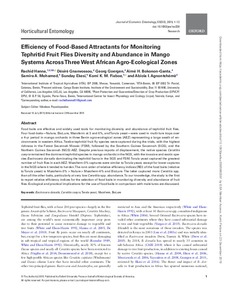| dc.contributor.author | Hanna, R. |
| dc.contributor.author | Gnanvossou, D. |
| dc.contributor.author | Goergen, G. |
| dc.contributor.author | Bokonon-Ganta, A.H. |
| dc.contributor.author | Mohamed, S.A. |
| dc.contributor.author | Ekesi, S. |
| dc.contributor.author | Fiaboe, K.K.M. |
| dc.contributor.author | Agnontchémè, A.I. |
| dc.date.accessioned | 2020-03-03T13:29:21Z |
| dc.date.available | 2020-03-03T13:29:21Z |
| dc.date.issued | 2019 |
| dc.identifier.citation | Hanna, R., Gnanvossou, D., Goergen, G., Bokonon-Ganta, A.H., Mohamed, S.A., Ekesi, S., ... & Agnontchémè, A.I. (2019). Efficiency of food-based attractants for monitoring tephritid fruit flies diversity and abundance in mango systems across three west African agro-ecological zones. Journal of Economic Entomology, 20(20), 1-12. |
| dc.identifier.issn | 0022-0493 |
| dc.identifier.uri | https://hdl.handle.net/20.500.12478/6805 |
| dc.description.abstract | Food baits are effective and widely used tools for monitoring diversity and abundance of tephritid fruit flies. Four food-baits—Nulure, BioLure, Mazoferm at 3 and 6%, and Torula yeast—were used in multi-lure traps over a 4-yr period in mango orchards in three Benin agro-ecological zones (AEZ) representing a large swath of environments in western Africa. Twelve tephritid fruit fly species were captured during the trials, with the highest richness in the Forest Savannah Mosaic (FSM), followed by the Southern Guinea Savannah (SGS), and the Northern Guinea Savannah (NGS) AEZ. Despite previous reports of displacement, the native species Ceratitis cosyra remained the dominant tephritid species in mango orchards in the NGS, with the invasive and exotic species Bactrocera dorsalis dominating the tephritid fauna in the SGS and FSM. Torula yeast captured the greatest number of fruit flies in each AEZ. Mazoferm-3% captures were similar to Torula yeast, except for lower captures in the NGS where it tended to harden. The rank order of relative efficiency indices (REI) of the food baits (relative to Torula yeast) is Mazoferm-3% > Nulure > Mazoferm-6% and BioLure. The latter captured more Ceratitis spp. than all the other baits, particularly at very low Ceratitis spp. abundance. To our knowledge, the study is the first to report relative efficiency indices for the selection of food baits in monitoring diversity and abundance of fruit flies. Ecological and practical implications for the use of food baits in comparison with male lures are discussed. |
| dc.format.extent | 1-12 |
| dc.language.iso | en |
| dc.subject | Bactrocera Dorsalis |
| dc.subject | Ceratitis |
| dc.subject | Torula |
| dc.subject | Yeasts |
| dc.subject | Tephritidae |
| dc.subject | Baits |
| dc.title | Efficiency of food-based attractants for monitoring tephritid fruit flies diversity and abundance in mango systems across three west African agro-ecological zones |
| dc.type | Journal Article |
| cg.contributor.affiliation | International Institute of Tropical Agriculture |
| cg.contributor.affiliation | University of California |
| cg.contributor.affiliation | Direction of Crop Production, Benin |
| cg.contributor.affiliation | International Center of Insect Physiology and Ecology |
| cg.coverage.region | Africa |
| cg.coverage.region | West Africa |
| cg.coverage.country | Nigeria |
| cg.coverage.hub | Central Africa Hub |
| cg.creator.identifier | Rachid Hanna: 0000-0002-5715-0144 |
| cg.creator.identifier | Georg Goergen: 0000-0003-4496-0495 |
| cg.researchtheme | Plant Production and Health |
| cg.identifier.bibtexciteid | HANNA:2019 |
| cg.authorship.types | CGIAR and developing country institute |
| cg.iitasubject | Agronomy |
| cg.iitasubject | Biodiversity |
| cg.iitasubject | Pests of Plants |
| cg.iitasubject | Plant Health |
| cg.iitasubject | Plant Production |
| cg.journal | Journal of Economic Entomology |
| cg.notes | Published online: 18 Dec 2019 |
| cg.accessibilitystatus | Limited Access |
| cg.reviewstatus | Peer Review |
| cg.usagerightslicense | Copyrighted; all rights reserved |
| cg.targetaudience | Scientists |
| cg.identifier.doi | https://dx.doi.org/10.1093/jee/toz338 |

